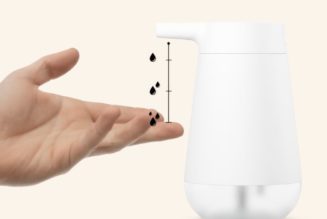It was taking staff all day to wrangle rapid test results at assisted living facilities like Via Elegante in Tucson, Arizona. The facility doesn’t normally run medical tests, but this year, it turned into a makeshift lab. Starting in August, staffers were doing hundreds of COVID-19 tests a week in the hopes of preventing a catastrophic outbreak.
The tests they use are fast; they only take about 15 minutes to report if someone is positive or negative for the coronavirus. But counting the results and reporting them to the state and local health departments was a long, arduous process each day, says Zach Briefer, the chief financial officer for the facilities.
COVID-19 is a reportable disease, so public health officials have to be told about every new case. But Via Elegante and other places like it aren’t directly connected to the public health system. Instead, for months, they had to use makeshift systems: Google Forms, faxes, manual spreadsheets, the mail. “We had to put in everyone’s info, one at a time,” Briefer says. “At the height, we were doing around 400 tests a week.”
Eager for a way to make that process easier, Via Elegante signed on as the first pilot site for a new rapid test reporting system built by the United States Digital Service (USDS) and Centers for Disease Control and Prevention (CDC). The tool, called SimpleReport, was designed to streamline the flow of data between nontraditional testing sites and public health officials.
“Currently, in our state, they’d have to input every single test result into a Google Form,” says Kat Davis, a member of the COVID-19 Response Team at Arizona’s Pima County Health Department. “It took all their time. For them, this is a huge time saver — they just hit submit and the reporting is complete.”
SimpleReport is being used at around 100 sites, and the team behind the program hopes to continue to scale it up around the country over the next few months. It fills a gap, but it’s more of a bandage than a long-term fix.
The time-consuming reporting delays that SimpleReport was designed to solve are a symptom of a more fundamental problem. There are huge holes in the US public health infrastructure. The rickety, outdated systems were unprepared to share and analyze data during an emergency, and those inadequacies are one reason the COVID-19 pandemic was so devastating in the United States. They’re not beyond repair, but it’s a hard task in the middle of an emergency. Many of the solutions spun up during the pandemic have failed: a program built to streamline the COVID-19 vaccine rollout was abandoned by many states after it proved chaotic and overly complicated. A new hospital data system was error-ridden.
“It’s like building an airplane while you’re flying it, so it doesn’t surprise me that there have been a lot of whiffs here,” says Jeff Engel, senior adviser for COVID-19 with the Council of State and Territorial Epidemiologists.
SimpleReport is still new, and early users say it’s much better than the systems they were using before. But experts caution that even if it succeeds in its goal of linking nontraditional testing sites to health departments for COVID-19 testing, there’s still a lot of work to be done.
“This is an area where I don’t think we’re anywhere near mission accomplished,” says Julia Adler-Milstein, a health IT expert and researcher at the University of California, San Francisco. “The fear is that you find an easy workaround, and then you lose motivation to keep trying to improve. I hope that, even if this works, it won’t be the final end state.”
:no_upscale()/cdn.vox-cdn.com/uploads/chorus_asset/file/22342748/1230021804.jpg)
Rapid COVID-19 testing is a key tool in reducing the spread of disease, especially in settings like long-term care facilities where people have to be tested regularly. Most rapid COVID-19 tests used in the United States today are antigen tests. The Food and Drug Administration (FDA) authorized the first of these tests in May, and they started to become more widely used through the late summer and fall.
They’re appealing because they’re fast, cheap, and show results on the spot without having to be sent to a lab. Instead of looking for bits of the coronavirus’s genetic material, they look for the tiny proteins on the surface of the virus. They can be less accurate than gene-based tests, but they also may be more likely to catch cases of COVID-19 when someone has a high level of virus floating around in their nose and throat (which is when they’re likely the most contagious).
There are lots of different kinds of tests on the market, including disposable cards and computer-sized machines, both of which can analyze samples on the spot. The result appears on the card or is displayed on the machine, usually in around 15 minutes. They’re easy for places like long-term care facilities to set up and use.
Because they’re done outside of typical lab environments, it’s harder for state and federal health authorities to collect data from these tests. Commercial laboratories and state health labs have a direct line to health agencies and can easily pass along COVID-19 test results. Places like long-term care facilities, schools, and pop-ups in parking lots can’t.
The limited digital connections many places where people get health care (like long-term care facilities) have with hospitals and health departments is a constant challenge, even outside of a pandemic. Health records don’t seamlessly follow patients from place to place, leaving facilities to sort out medications and advice from multiple doctors for a single patient. When connections are put in place, patients are less likely to cycle in and out of hospitals.
During an emergency like COVID-19, those inefficiencies can be deadly. Without a clear path from long-term care facilities to health departments, it can take days for officials to get word of positive tests. That can delay contact tracing — and make it harder to stamp out an outbreak.
Transmitting test results was anything but straightforward for facilities with limited experience communicating with health departments. “Reporting the results to the local health department or the state health department was a complete mystery to these sites,” says Engel.
That created data gaps: in September, half of states said their antigen test results were probably underreported. The problem persisted through the fall. Like Via Elegante, many assisted living facilities were using makeshift online forms or sending off physical copies of test results to their local health departments.
“We saw a lot of duplicate entries, with people handwriting the same thing on two different forms; we saw people faxing a lot of information,” Amy Gleason, an expert with the USDS who worked on SimpleReport, told The Verge.
Those problems came to light last spring and summer, as the USDS spent time visiting health departments and hospitals in a handful of states to figure out what their biggest challenges were during the pandemic. By early fall, they recommended that the CDC should focus on creating a streamlined way for nontraditional testing sites to manage rapid testing and report results. SimpleReport came out of that process.
:no_upscale()/cdn.vox-cdn.com/uploads/chorus_asset/file/22342680/SimpleReport_View.png)
The program lets staffers at a testing site pull up a digital card with places for a patient’s name, symptom survey, the date of their last test, and test timer. A facility can process multiple tests at once and has the option to change the test date. Both of those features came out of conversations with long-term care facilities about their workflows, says USDS’s Alicia Beckett.
“Our first version of the prototype only let you look at and manage one test at a time,” she says. They also adjusted the system to sync the in-progress tests between devices.
Before starting with SimpleReport, Via Elegante staffers had to report COVID-19 test results in three different places: a Google Form for the state, an Excel list for the county, and internally for the facility’s own records. When they started using the program in early December, they were able to cut out those redundancies. They phased out internal records and the county list quickly, Briefer says. The Arizona Department of Health Services asked for a more extensive validation process before it felt comfortable that the data from the new workflow matched the data coming in through the Google Form. But eventually, Via Elegante was able to drop the Google Form as well. The Arizona Department of Health Services did not respond to a request for comment.
Having a single reporting system has slashed the administrative work from around three minutes to seconds per test, Briefer says. For hundreds of tests a week, that adds up. “That has really allowed us to do our real jobs,” he says. “It’s a lot easier and everyone is a lot less stressed.”
SimpleReport’s 100 sites are spread across eight states. The team is in discussions with a handful of other states as well. In Florida, they’re working with mobile testing sites and urgent cares; in a few other places, they’re talking with colleges and universities.
The program will get up and running more quickly going forward, now that the USDS team has gone through the initial pilot phase. Other states aren’t asking for the same extensive data validation as the Arizona Department of Health Services. USDS is building onboarding videos and support programs for new sites. “We can’t have the same high-touch, hands-on process we did with the first site for the 100th site,” Beckett says. “But we’re working on making sure that it’s as easy as possible for folks to do themselves.”
:no_upscale()/cdn.vox-cdn.com/uploads/chorus_asset/file/22342705/1229965852.jpg)
Engel, the adviser with the Council of State and Territorial Epidemiologists, says he’ll be watching closely as the program starts to scale. “We offered our help, because the projects they were doing were helpful, but we were concerned that they wouldn’t be sustainable, or scalable,” he told The Verge. “We’re still trying to work that out.” He doesn’t want to see a situation with a handful of one-off tech solutions that fade off without maintenance, and he says he’s concerned that sites will struggle to implement SimpleReport without the hands-on support of the pilot sites.
Right now, USDS has a user guide and email address for questions, Beckett says. Eventually, it’ll route questions through a general Department of Health and Human Services help desk. The CDC is funding SimpleReport’s development, and it’s assumed responsibility for the program’s long-term sustainability. It’s also an open-source program, she says. “If anybody else wanted to maintain it and add to it, they could.”
Even if SimpleReport does prove to be a good solution for test reporting, it doesn’t solve the underlying issue: many places testing, treating, or vaccinating patients aren’t well-connected to the public health infrastructure. If they were, facilities like Via Elegante wouldn’t need a new pandemic-specific tool. They would have a direct pipeline to health departments already.
Instead, during an emergency like the COVID-19 pandemic, groups like USDS come in and develop makeshift solutions. “We keep developing these stovepipe systems that are doomed to failure,” Engel says. “Our data systems are in bad need of upgrading.”
Something like SimpleReport is a reasonable place to start, says health IT expert Adler-Milstein. There’s so much to do, and taking the problem one case at a time makes sense — it just can’t be the place to stop. Connecting long-term care facilities with the rest of the system would make it more efficient to care for patients and build a stronger foundation for future emergencies when fast communication saves lives.
Adler-Milstein says she’s hopeful the pandemic highlighted the need for better connectivity, and that next time, our systems will be more prepared. “How much we’ll advance remains to be seen — but will we have advanced? I’m pretty confident that there will be improvements,” she says.
Even as that momentum ticks forward, places like long-term care facilities will still need ways to report test results to health departments. The emergency phase of the COVID-19 pandemic will likely fade out over the summer, and millions of people are getting vaccinated each week. But the virus isn’t going away completely and could still be a threat to the most vulnerable.
Briefer says Via Elegante will be running regular COVID-19 tests — and using SimpleReport — for at least another year. Most residents and around half of the staff have had their first doses of the COVID-19 vaccine, but testing programs will stay in place. “From where we stand, we aren’t changing anything,” he says.










